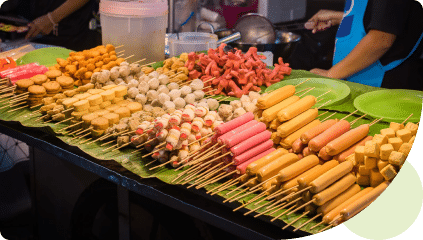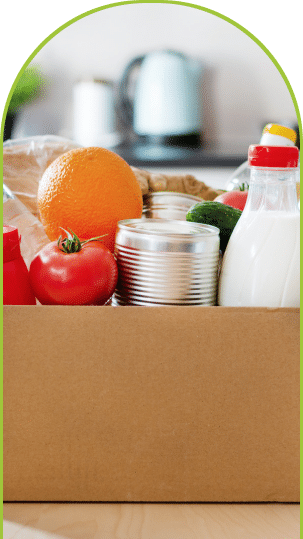Food Safety for
Travelers
Food is an integral part of any international travel experience, but sampling local cuisine also carries the risk of foodborne illness. However, that doesn’t mean you have to miss out on all the unique flavors of your travel destination. Careful planning, a few simple precautions, and some basic knowledge about food safety for travelers can help you stay healthy and enjoy your trip to the fullest.
KEY TAKEAWAYS
- Food poisoning while traveling is normally caused by consuming contaminated food or water, with different pathogens posing a higher risk to foreigners unaccustomed to local diets.
- “Traveler’s sickness,” the most common type of food poisoning among travelers, is usually caused by bacteria in hot or humid climates and can lead to symptoms like diarrhea and abdominal pain.
- Certain foods and beverages, such as street food, salads, buffet food, unpasteurized dairy, and tap water, pose a higher risk of foodborne illness due to factors like inadequate refrigeration and poor sanitation.
- For safer eating and drinking while traveling, it’s recommended to drink bottled water, avoid street food with poor sanitation, opt for sit-down restaurants, and choose cooked foods over raw.
- After returning from travel, it’s important to monitor your health and check in with your doctor, as some foodborne illnesses can have delayed symptoms.

Nausea, vomiting, diarrhea, and stomach cramps are not exactly the memories you want to take home from your dream vacation. Unfortunately, food poisoning is an all-too-common experience among international travelers.
With the right approach, you can greatly reduce your chances of getting sick abroad. This guide to food safety for travelers from Keep Food Safe will arm you with the necessary knowledge to protect yourself while enjoying the local cuisine on your next trip.
How Does Food Poisoning Occur While Traveling?
Food poisoning is a broad term that refers to any illness caused by consuming contaminated food or beverages. Contaminants like bacteria, viruses, parasites, and toxins all have the potential to cause foodborne illness.
There are a few reasons why food poisoning is more likely while traveling internationally. One of the most significant factors is the variation in common pathogens when crossing borders. Where locals may have developed immunity and tolerance to certain pathogens due to more frequent exposure, a foreigner’s body may not be as prepared to fight them off.
Food hygiene and water sanitation practices also differ between countries. Developing nations, in particular, may not have the same stringent regulations and health standards as other countries. This can result in food being prepared and stored in less-than-safe conditions, thus increasing the risk of contamination.
Keep in mind that some cases of perceived food poisoning may instead be a simple reaction to unfamiliar ingredients. For example, spicy food often causes digestive discomfort in people unaccustomed to this kind of cuisine. Similarly, some people may be allergic to certain food items more common in the country they’re visiting than back home.

Traveler’s Sickness
“Traveler’s sickness,” sometimes known as “traveler’s diarrhea,” is the most common type of food poisoning affecting international travelers. It affects up to 70 percent of travelers. Any gastrointestinal infection occurring during travel or soon after returning home may fall into this category.
Bacteria are usually to blame, but viruses and parasites can also cause traveler’s sickness. Hot or humid climates allow these harmful bacteria to proliferate more easily. This explains why travelers from cooler regions are more likely to experience traveler’s sickness in tropical regions of Latin America, Asia, Oceania, and Africa.
Symptoms of traveler’s diarrhea usually appear between 6–24 hours after exposure to contaminated food or water. Individuals may experience loose, watery stools, as well as abdominal pain and cramping. Traveler’s sickness can also cause nausea, vomiting, and fever. Symptoms are usually mild and resolve on their own, but severe cases are also possible and may lead to severe dehydration. Treatment may require antibiotics.

Foods To Be Cautious of When Traveling
Any type of food or beverage has the potential to cause food poisoning, but certain items are more likely to be contaminated than others. Although the risk of sickness can’t be completely eliminated, being particularly cautious around specific types of food and beverages can greatly reduce your likelihood of contracting a foodborne illness. This is especially important for individuals at increased risk for food poisoning, such as young children, pregnant women, and older individuals.
Street Food
“Street food” includes any type of prepared food sold by a vendor in a market or at a roadside stand for immediate consumption. This food category is a popular and convenient option for travelers looking for an authentic bite to eat, but street vendors often do not maintain the same cleanliness and sanitation standards as restaurants. For example, outdoor food stands may not have proper refrigeration or hand-washing facilities, which makes food contamination more likely.
Salads or Fresh Produce Items
Salads, cut fruit, and other items containing fresh produce may seem like a healthy option while traveling, but they also pose a heightened risk for foodborne illness. Raw produce often contains harmful bacteria or parasites introduced through the soil, water, or food-handling practices during harvesting and packaging.
Washing fresh produce reduces the risk of unsafe contamination to safe levels. However, remember that food safety standards in some destinations may not involve rigorous washing protocols.
Buffet Food
Buffet-style dining is common in many travel destinations, especially in all-inclusive cruises and resorts. While a buffet’s variety and abundance may seem tempting on a busy travel day, food safety risks are higher in these settings. Buffet food is often left at room temperature for extended periods, which increases the risk of bacterial growth. Additionally, guests with unwashed hands may touch shared serving utensils, potentially contaminating the food with any pathogens they’ve been exposed to. Norovirus is a common foodborne illness from buffet-style dining.
Unpasteurized Milk and Dairy Products
Pasteurization is a process that kills bacteria naturally occurring in milk and dairy products. Many countries require pasteurization of all milk and dairy sold within their borders, but unpasteurized (“raw”) dairy products are readily available for purchase in many parts of the world. While these products are often considered cultural delicacies, they can also carry harmful bacteria like E. coli, Listeria, and salmonella.
Tap Water and Ice
Water treatment standards vary widely around the world, and tap water in some destinations may not be safe for consumption. Drinking contaminated water can lead to severe illnesses like Rotavirus, E. coli, and Hepatitis A. Because freezing does not kill bacteria and other pathogens, the same goes for ice cubes made from tap water.
Before you embark on your next international adventure, check the Sanitation & Drinking Water rankings created by the Environmental Performance Index at Yale University to investigate your destination’s tap water quality. If your destination ranks low, stick to bottled water and avoid ice cubes in drinks.
Bushmeat
Trying exotic dishes is often a highlight for adventurous international travelers. For example, in markets around the world, you can find monkey, bat, and rodent meat available for consumption. However, it’s best to avoid consuming the meat of wild animals, otherwise known as “bushmeat,” as it can carry extremely dangerous bacteria and viruses (e.g., Ebola). It’s also important to consider the impact of consuming endangered or protected species. In many cases, doing so is highly illegal.

What Is Safe To Eat and Drink While Traveling?
When considering food safety for travelers, you may find it easier to focus more on what is safe to eat than what is not. Complete food safety can never be guaranteed, but certain categories of food and beverages are safer to consume than others while traveling.

Foods Served at Hot Temperatures
Heat kills bacteria at temperatures of 165°F (74°C) and above, so it’s usually safe to eat foods that have been thoroughly cooked and served while hot. Be cautious with food that has gone cold or is kept hot for an extended period using warming lamps.
Packaged or Preserved Foods
Bacteria need moisture and oxygen to grow. Pre-packaged foods both eliminate moisture and limit the availability of oxygen, so they are usually safe to eat if they remain sealed. Familiar examples include crackers, chips, canned goods, boxed meals, and dried foods (e.g., jerky and fruits).
Cooked Meats
Meat must be cooked to a safe internal temperature to kill any bacteria present. The more “well done” the meat, the lower the risk of contracting foodborne illness. Stick to well-cooked meats, seafood, and poultry when traveling to maximize safety.
Washed Vegetables and Fruits
Again, unwashed fruits and vegetables can carry bacteria that may make you sick, but washing them before consumption significantly reduces the risk. If you’re unsure about the sanitation practices at your destination, it’s best to opt for cooked produce instead.
Bottled Water
Bottled water is a safe option for staying hydrated while traveling, especially in developing countries where tap water may not be safe to drink. To stay on the safe side, avoid drinking local tap water altogether.
Pasteurized Juices
Another safe beverage option is pasteurized juice. Not all juice is pasteurized, so be sure to check labels before consuming.
Beer, Wine, and Other Alcoholic Drinks
Alcohol doesn’t always eliminate bacteria, but it does discourage bacterial growth. However, other food safety precautions still apply here, especially when consuming mixed beverages. Alcoholic beverages containing ice, garnished with fresh produce, or mixed with potentially contaminated water can still pose a food safety risk.
Soda and Other Bottled Drinks
Soda and other bottled drinks are generally safe to consume as long as their seal is intact. Just remember to avoid adding ice to your drinks in destinations with questionable tap water quality.
Most Common Foodborne Illnesses While Traveling
A handful of pathogens are responsible for the majority of foodborne illnesses. Most of these pathogens are bacteria, and a few are viruses. If you develop a foodborne illness while traveling, chances are the responsible pathogen will be one of the following:
E. coli
Escherichia coli, more commonly known as E. coli, is a group of bacteria with multiple strains. Most E. coli strains are harmless, but a few can cause gastrointestinal illness involving bloody diarrhea, vomiting, and severe stomach cramps.
The most common strain that causes illness is E. coli O157:H7. It’s mainly found in contaminated meats, particularly undercooked ground beef, as well as raw vegetables and unpasteurized milk.
E. coli may also be present in water, as contaminated fecal matter can infiltrate water sources through sewage or runoff in agricultural areas. Drinking tap water in a country with poor water sanitation infrastructure is one of the many ways you can contract E. coli while traveling.
Salmonella
Salmonella is a type of bacteria that can cause salmonellosis if ingested. Salmonella infections typically involve gastrointestinal symptoms like diarrhea, fever, and stomach cramps.
Food that has been contaminated with fecal matter is the most common source of salmonella. Poultry and eggs are common carriers of the bacteria, but it can also be found in raw milk and fresh produce. These foods usually collect bacteria early in the harvesting process.
Food may also become contaminated with salmonella if handled by someone who has the bacteria on their hands. For example, this can occur if they do not wash their hands thoroughly after using the bathroom or handling uncooked meat.
Cholera
Cholera is a bacterial disease caused by the Vibrio cholerae bacteria. It causes severe diarrhea, dehydration, nausea, and vomiting and can be fatal within hours of infection if left untreated.
While cholera outbreaks are rare in developed nations, they still occur regularly in nations with poorly developed sanitation systems. Contaminated water is the most common source of cholera, but it can also be transmitted through contaminated food, such as seafood, raw produce, and grains.
Cholera proliferates more easily when contaminated food is left at room temperature for extended periods. For example, dishes prepared in the morning and served later in the day without refrigeration pose a higher risk for cholera contamination, particularly in regions where the bacteria is more common.
Norovirus
Norovirus is a highly contagious virus that causes acute gastroenteritis, commonly known as the stomach flu. Norovirus is the leading cause of foodborne illness worldwide, causing symptoms like nausea, vomiting, and diarrhea.
The virus can spread through fecal matter and vomit. Direct contact with an infected person, consuming contaminated food or water, and touching contaminated surfaces can also lead to transmission of the virus.
One of the ways travelers may contract norovirus is by eating from a buffet on a cruise ship or an all-inclusive resort. If an infected traveler who hasn’t washed their hands after using the restroom touches the serving utensils or food, the virus can quickly spread to other guests.
Listeria
Listeria monocytogenes, more commonly known as Listeria, is a bacteria that can cause listeriosis, especially in newborns, people over 65 years of age, those with weakened immune systems, and other vulnerable populations. People in good health rarely get sick from listeriosis, but it can still be a concern for many travelers. Pregnant women are also more susceptible to sickness, which can cause miscarriage, stillbirths, and premature delivery.
Symptoms typically include fever, chills, muscle aches, nausea, and diarrhea. It can take 30 days or more for symptoms to appear after the initial infection.
Listeria can be found in soil, water, and animal feces. The most common food sources of Listeria infections include raw vegetables, unpasteurized milk, soft cheeses, hot dogs, and deli meat. Some of these foods, such as deli meats, are contaminated after processing. Eating high-risk foods in areas where cross-contamination with raw meat is likely, such as markets, increases the risk of infection.
Hepatitis A
Hepatitis A is a viral infection that leads to liver inflammation. Symptoms include fever, fatigue, loss of appetite, vomiting, diarrhea, intense itching, and yellowing of the skin and eyes. Though not everyone develops symptoms, those who do usually experience mild cases that resolve in a few weeks. However, more severe cases are possible, sometimes resulting in months of illness and permanent liver damage.
The virus is more common in certain parts of the world, such as Latin America. It usually spreads when fecal matter contaminates food and water due to inadequate hand washing after using the toilet. Bodies of water can also become contaminated with Hepatitis A when polluted with sewage. Eating raw shellfish harvested in these waters is a significant source of Hepatitis A infection when traveling abroad.
Legionnaires’ Disease
Legionnaires’ disease, a serious type of pneumonia, is caused by the Legionella bacteria, which is commonly found in water. Travelers should note that it is normally contracted by inhaling contaminated water droplets, not through food consumption. Risky sources include hotel air conditioning, showers, and hot tubs.
Symptoms like cough, fever, and muscle aches can develop 2–10 days after exposure, resembling the flu but potentially leading to severe respiratory issues. High-risk groups include older adults, smokers, and those with weakened immune systems. While rare in food settings, awareness and caution in environments with water aerosols are essential. Seeking immediate attention if symptoms arise is crucial.
Tips for Food Safety While Traveling
Traveling doesn’t have to mean putting your health at risk. By taking food safety measures before, during, and after your trip, you can significantly reduce your chances of getting sick.
Preparing Before the Trip
Food safety for travelers starts before you ever leave the comfort of your home. A little preparation can go a long way in protecting yourself from foodborne illnesses when traveling. Here are some must-have items to bring:
- Travel-sized hand sanitizer
- Single-use disinfectant wipes for cleaning surfaces
- Non-perishable snacks for when you can’t find safe food options
- Water purification tablets in case you need to drink potentially unsafe water
- Over-the-counter remedies for common travel illnesses, such as antidiarrheal medication, fever reducers, and electrolyte packets
- A thermometer to monitor your body temperature in case of illness
Be sure to research your destination to evaluate the risk of contracting a foodborne illness. Learn about the water supply, food safety regulations, and common illnesses in the area. Simply being informed can help you make safer food choices while traveling.
Additionally, take some time to check your health insurance coverage before international travel. If yours doesn’t cover out-of-country medical expenses, consider purchasing additional travel insurance that includes medical coverage while abroad. You may also want to visit your doctor before embarking on your trip to make sure you’re in good health and up to date on all necessary vaccinations.
Eating and Drinking During the Trip
When you arrive at your destination, be mindful of your food and beverage choices. Here are some tips to keep in mind:
- Always drink bottled water instead of tap water, especially in areas with poor water quality. Boil water or use water purification tablets if bottled water isn’t an option.
- Avoid consuming beverages with ice.
- Be cautious when buying street food. If you choose to eat street food, observe the vendor’s sanitation practices and trust your instincts. If something doesn’t seem safe, it’s best to err on the side of caution and look for food elsewhere.
- Stick to restaurants recommended on reputable travel sites.
- Choose sit-down restaurants instead of buffets.
- Avoid eating room-temperature food.
- Opt for cooked foods over raw foods whenever possible.
Hygiene During the Trip
Your hygiene practices while traveling are just as important as the food and drinks you consume. Be sure to implement these best practices:
- Always wash your hands or use hand sanitizer before eating or handling food. Only use trusted water sources to wash your hands.
- Avoid touching your face, especially with unwashed hands.
- Clean surfaces with antibacterial wipes before eating.
- Don’t share utensils or drinks with others.
- Use bottled water instead of tap water to brush your teeth.
- Only bathe or shower using water from safe sources.
What To Do After the Trip


What Should I Do if I Experience Food Poisoning While Traveling?
If you experience food poisoning while traveling, take care of yourself by:
- Drinking plenty of bottled water and electrolyte-rich fluids.
- Resting as much as possible to allow your body to recover.
- Consult a pharmacist about taking over-the-counter medication for symptoms like nausea, vomiting, diarrhea, and fever.
- Seek medical attention if symptoms persist or are severe.
You may also want to gather evidence in case you need to take legal action later on. Keep track of what you eat and where you eat it, take photos of any questionable food or unsanitary conditions, and save documents from any medical treatment you received.
When you’re back home, consider working with a food safety lawyer. Depending on the circumstances of your case, you may have the right to seek compensation for your illness by filing a food poisoning lawsuit against the liable party. A lawyer can help you determine if you have a viable case, gather evidence, and navigate the legal process on your behalf.
